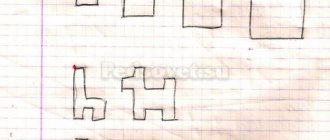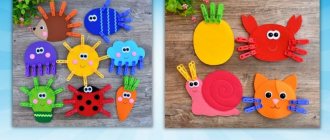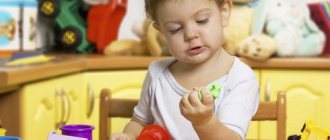Development of fine motor skills in children
Exercises after 3 years
Beads and cereals
This category includes games with small objects. It can be anything - beads, beads, various cereals, etc.
You can start with larger items. For example, large beads that a child will play with great interest in his hands.
Another option is cereals. Pour buckwheat or other cereal into a bowl and give it to your baby. He will touch it, roll it in his fingers. In this way, children develop tactile sensations and fine motor skills well.
You can add some kind of goal to these activities. For example, pour buckwheat onto the table and ask your child to separate the black grains from normal buckwheat. You can also ask him to sort the beads by color.
Screwing and unscrewing lids
Developing fine motor skills by screwing or unscrewing bottle caps (it’s better to choose different sizes) is a good exercise for developing dexterity in children’s fingers.
A similar effect is achieved by unfastening and fastening zippers and buttons. In addition, this way the child quickly learns to be independent. You can gradually develop in your child the understanding that he must button his own jacket, lace his shoes, etc.
Modeling
It is suitable for children of different ages. You can use different materials - plastic dough, plasticine, clay. Try to add variety to your classes every time. For example, if at first you just give your child plasticine, and he tries to mold something out of it, then later you can add some objects to the lessons and tell your child to stick plasticine around them. Handprints and various objects can be made from clay.
Parents can be advised to take their child with them to the kitchen when you want to bake something. Let your baby work with the dough, knead it with his hands, but be careful and remove all sharp objects.
Sand games
There are many different variations possible here. The child can draw with his finger in the sand, you can hide some objects and ask the child to find them in the sand. Such activities are only suitable for children over 3 years old, because young children put everything in their mouth.
Drawing, cutting, puzzles, construction sets
Cutting out figures and various objects from paper has an extremely beneficial effect on the development of fine motor skills. Here you need to start with something simple (cutting out shapes with straight lines) and move on to something more complex (cutting out shapes with curved lines, snowflakes, etc.). Carving is also useful because it develops spatial perception.
The same goes for drawing. At first, you can simply give your child a felt-tip pen and full scope for creativity. Then ask him to complete the missing part of the drawing, draw a line along the contours, etc.
Construction sets and puzzles not only develop fine motor skills, but also have a beneficial effect on a child’s imagination, memory and creativity. In addition, the baby develops patience and perseverance. There are a large number of options on sale for children of different ages.
1. ROLLING BALLS.
Children roll small balls around the table (along the playing field on which you can draw different paths - straight, curved, spiral). During the game, the ball should not slip out from under the palm and should roll exactly along the path. Tell your baby: “The balls are naughty! So they try to run away. Don’t let them go!” Balls can be rolled either with your palms (in the first games) or with one finger (in subsequent games).
2. GAME WITH RAISINS.
Always very joyful for both mother and child and useful for the whole family. Make the dough, roll it out. Invite your child to decorate the dough with raisins. Show how to correctly grasp the raisin (“tweezers grip” with two fingers – thumb and forefinger). Show that the raisins should be placed throughout the dough at a distance from each other. Then bake the resulting pie and eat it with the whole family! Joy guaranteed!
3. SORTING SMALL ITEMS
It is very important that the baby does this either with a pinch (with three fingers) or with a “tweezer grip” method (grabbed with two fingers – the thumb and forefinger). At the same time, the remaining fingers should be bent and not interfere. Show your child the correct way to do this exercise.
Mix two types of beads (or peas and beans; or shells and pebbles, or buttons of different shapes and sizes) in one box and ask for help. You can sort by color (if you mixed beads of two colors), by shape, by size. First, the baby sorts two types of fairly large objects. Then the task becomes more complicated - smaller objects are taken and sorted into 3-5 groups (for example, beans in one box, peas in another, beads in a third, pebbles in a fourth, shells in a fifth).
Sorting always happens in the game. For example, our chicken loves peas, and our rooster loves beans. We need to divide the food into bowls for them.
Or one doll likes pasta, and the other likes beans. You need to give everyone what she loves.
Sorting small items is very important in the third year of a child's life.
4. KNEADING PLASTICINE.
Before sculpting, be sure to let a child of any age knead the plasticine. This is a very useful exercise for developing fine motor skills. In this regard, ordinary domestic plasticine is much more useful than soft imported plasticine.
5. STRINGING RINGS ON THE PYRAMID ROD (development of correlating hand movements).
First, the baby learns to disassemble the pyramid toy (this is easier), and only then assemble it. Please note that even the smallest children easily remember the sequence of colors in a pyramid and assemble it simply from memory, and not from comparing values. Therefore, if you want to teach them to compare the size of the rings and arrange them from largest to smallest sequentially, then you need a pyramid with rings of the same color!
6. OVERSLEEPING.
Using a funnel, scoop, or spoon, pour various bulk substances from one container to another. You can add sand, cereals, peas, and lentils. Use different dishes - you can pour it into a glass, a vessel with a narrow neck using a funnel. You can pour sand into the box with your hands, hide and look for various small toys in the sand.
7. GAMES – LACING (lace an apple to the hedgehog’s back, clothing parts and other story lacing).
These games quickly get boring for the baby. Therefore, it is better if you have a doll whose shoes or clothes are tied with a lace. By putting on and undressing this doll in play, your baby will easily and happily practice tying.
8. EXERCISES WITH PAPER:
1) crumple - development of hand strength (after this you will get a “ball” that can be thrown into the basket from a distance), 2) tear (development of correlative movements) - grab the sheet with the fingers of both hands and pull in different directions. You get stripes. We put these strips in a box and make it “rain” by pouring our strips out of the box.
Important Tips:
- When offering your child paper for this exercise, you should always show him where he can get the paper from. And they themselves must always take paper for this game only from this box. Otherwise, the baby will understand that it is possible to tear everything that is around and will tear books or something else necessary. There is always a place for this exercise.
- Don't let us tear up old books and magazines. With any game we develop an attitude towards life. And this is an example of unacceptable treatment of a book. In addition, printing ink is not at all healthy for small children.
- You can use old rolls of wallpaper for this exercise.
3) make appliqués from paper balls (crumple the paper, tear it into strips, then tear the strips into squares, roll each square on your palm into a ball, lay out a silhouette with balls - for example, a cat, a lamb, a cloud)
4) make appliqués from pieces of paper that the baby tore. Draw a picture on a piece of whatman paper. And stick pieces of paper on it according to the plot. White glued pieces can represent snow or clouds, blue ones can represent a river, yellow ones can represent autumn foliage of trees.
9. PRESSING SMALL OBJECTS INTO PLASTICINE (beads, seeds, shells, small pebbles).
So we can make paintings - mosaics on plasticine. You can also help the hero of the game - for example, make a “blue river” (smear plasticine on a strip of cardboard) and build a bridge across the river (press pebbles into the plasticine). And then the toys will walk across this bridge and thank the baby for his help.
10. RUBBER PEAR.
Choose a small pear (available at the pharmacy). By pressing it, you get a stream of air that can be used to blow away a piece of cotton wool or a leaf from the table. You can even play football, trying to force cotton wool into the goal with a stream of air. For children of the first year of life, a pear is not needed; this role is performed by rubber toys - squeakers, by playing with which the baby develops hand strength.
11. SPINNERS.
First, the baby learns to launch a spinning top, and then large-sized tops. And after that, give the baby small tops. Instead of a top, use any other objects: pyramid rings, balls, plastic bowls, etc. It is also useful to wind wind-up toys with a key.
12. USE OF CUTLERY - SPOONS, FORKS.
The ability to independently eat with a spoon, fork, or drink from a cup is also a very important component of a child’s development and the development of fine motor skills.
13. UNPLOCKING AN OBJECT WRAPED IN PAPER – SURPRISE – “WHAT’S THERE?”
When the baby unrolls the paper and finds the gift and plays with it, wrap it again - hide it in another paper. And try to find again. Teach your child to wrap - to hide an object from an older sister or brother, dad, or grandmother. Let them rejoice when his surprise is unwrapped.
14. FILLING THE BOTTLE WITH SMALL OBJECTS.
You can put beans, pebbles, and balls into a plastic bottle.
To make this exercise effective, show your child how to do it correctly:
- Grasp small objects either with a pinch or with two fingers (thumb and forefinger) - just show how you grab the object.
- Hold the bottle with one hand and take one part at a time with the other hand. It is very important to ensure that your baby picks up correctly and one piece at a time!
- At the end, close the bottle with a lid and rattle the resulting rattle.
15. CONSTRUCTORS.
Various construction toys develop fine motor skills very well. It is important to have several construction sets at home (but always with DIFFERENT principles for connecting parts). Making crafts and working with clay is also very useful.
16. STRINGING BEADS WITH LARGE HOLES ON A LAND.
I saw a very good idea for stringing at the Solnyshko kindergarten in Moscow. Teachers at this kindergarten collect old, unwanted markers with plastic casings. This body is sawn into pieces. The result is multi-colored “tubes” that children string on a cord like beads.
You can also string spools of thread, rings for curtains, parts of construction sets, beads made of clay or salt dough, rings from small pyramids.
17. TURN THE PAGES OF THE BOOK ONE AT A TIME.
This exercise is available to children from one year onwards. To do this, the pages of the first book must be thick, made of cardboard.
Show your child the book. And on the next page put a picture - a surprise. To find it, you need to turn the page. If it is difficult for the baby, then help him by slightly lifting the page.
18. UNLOCK AND TIE KNOTS, BOWTS, BRAID, UNLOCK AND FASTEN VELcro, BUTTONS, BUTTONS, HOOKS, ZIPPERS, REMOVE AND PUT ON A HAT, TAKE OFF SOCKS, TAKE OFF SHOES.
Although most often in modern families the task of children mastering different types of fasteners is solved with the help of an educational book or rug, this is just the first stage. Then the baby trains to do this in life, in everyday life.
The baby's clothes should have different fasteners - buttons of different shapes and sizes, buttons. It should be taken into account that it is much easier to fasten the clasp on a rug or another person than on yourself.
The situation when a child has only Velcro on his clothes and shoes throughout preschool age leads to the fact that even second-graders at 8-9 years old are not able to dress themselves if the clothes have a different type of fastener, and they cannot even tie their shoelaces when changing clothes in physical education! But a child’s lack of independence and dependence on an adult directly affects his future behavior and success in life.
Already at an early age, the baby can take off and put on a hat, stretch out his arms when putting on a sweater, put on and take off mittens and gloves, pull off socks, take off boots, put his hands in the sleeves, and his legs in his trousers, take off unbuttoned panties, a coat, a jacket - and This is also a contribution to the development of the baby’s fine motor skills, and a very big contribution.
19. LAYOUT FIGURES FROM STICKS, FROM DIFFERENT TYPES OF MOSAICS.
20. OPEN AND CLOSE JARS (unscrew and tighten the lids).
To make it more interesting, hide the surprise inside by wrapping it in paper. At the same time, the baby will practice unfolding and folding paper. What's hidden in the jar?
21. WINDING.
Winding a thick thread onto a stick, onto a spool, onto a ball and unwinding. Winding a thick cord around your hand - yours or your mother's.
22. ROLLING A PENCIL BETWEEN YOUR PALM.
First, try rolling the pencil on the table with your palm. Then show your baby how to roll a pencil between straightened palms in his hands (the pencil is in a vertical position). You can glue a picture to the end of a pencil that will “dance” - spin.
Why is it important to develop fine motor skills?
The connection between the mobility of fingers and the brain, in particular speech, was first identified by V. M. Bekhterev. “The hand is the brain coming out,” Kant also wrote.
This means that any deep psychological processes (conscious, unconscious) are always reflected in the position of the hands and gestures.
Teacher V. A. Sukhomlinsky Fr.
Such phrases are due to the fact that movements of the hands and fingers are directly related to the center of speech. Moreover, each finger has its own projection.
Important! Fine motor skills affect thinking and imagination skills and are associated with motor and visual memory. By developing it, the child becomes observant, attentive, and better expresses his thoughts and desires. Its level is one of the indicators of a child’s intelligence readiness for school.
The benefits of play for child development
Each game is educational: it brings new knowledge, develops a skill, trains memory, develops thinking, speech, sensory development, spatial perception, the ability to compare and analyze, etc.
A “correct” educational game does not have strict rules and gives the opportunity to fantasize, create, and come up with your own.
The game operates on the principle of “play-feel-learn” and consistently provides not only a non-boring pastime, but also a technological learning model based not on the conscious need to acquire knowledge, but on constant interest and creativity, both for the child and for the adult.
Useful toys
- Pyramid.
- Sorter.
- Mosaic. Any, all kinds of shapes, materials, sizes!
- Magnetic construction set and magnetic mosaic (magnetikus type).
- Construction set with hammer and nails on a cork board.
- Designer with large screws.
- Lego Duplo and classic Lego (as soon as the child stops tasting the parts).
- Play-Doh modeling kits (or cheap equivalents).
- Montessori toy sets. For example, special tongs and tweezers for carrying objects.
- Toys with Velcro.
- Business boards.
FINGERS PLAYING
However, the most interesting activity for children is finger games: all kinds of rhymes, tongue twisters, nursery rhymes, mini-performances that are performed only with the help of fingers. Here we present several new options for finger games.
But first, here are a few rules for conducting activities that develop fine motor skills:
- Work with your child regularly, include hand massage, games with small parts, creative activities, and finger exercises in your training program.
- Finger gymnastics should last from 5 to 15 minutes, no more, otherwise the baby will get tired and switch his attention to something else.
- Before starting the exercises, you need to warm up your palms by actively rubbing them against each other.
- Remember that now it is difficult for children to perform movements with both hands at once, so start with one, then repeat with the other, and only after that try to synchronize the hands.
- Keep in mind that the child may not remember all the movements or words of the game the first time, this is normal at their age. Everything will work out gradually.
- The baby will also learn to correlate words with movements during the lessons; if he doesn’t succeed right away, encourage him and help him perform the action.
- Move from simple to complex. If a child is offered an exercise that he cannot do, next time he will simply refuse to play.
- Try to interest your child by organizing games with his favorite characters, melodies, and rhymes.
- Do not exercise if your baby is unwell or in a bad mood. Don't force it. There are no useful games against the will of the player.
Other useful materials on the site
- Games for developing a child's speech.
- Games with wooden blocks you never knew existed.
- Useful games with a 2 year old child.
- Useful games with a 3 year old child.
- Skills and abilities of a 3-4 year old child.
- What to do with your child at home: a collection of simple and exciting ideas.
What games do you use to develop your child’s fine motor skills?
WHAT CONTRIBUTES TO HANDBOOK DEXTERITY?
There are many ways to make little fingers more skilled. The following games and activities perfectly develop fine motor skills in children aged 3–4 years:
- fastening buttons, snaps, lacing;
- unscrewing lids on jars and bottles;
- rolling pencils, nuts, spools in the palms;
- modeling from plasticine or dough;
- sorting of cereals (peas, beans, buckwheat, rice);
- finger painting on sand, semolina or buckwheat;
- drawing with finger paints or pencils;
- cutting out figures along the contours;
- games with small details (constructor, mosaic, puzzles);
- stringing large beads on fishing line or wire;
- feeling surfaces made of various materials and textures;
- massage with spiked balls.
When your child paints with finger paints, put on things that you don’t mind getting damaged by paints, and cover the table with protective oilcloth to make subsequent cleaning easier.
Most of these activities captivate children 3–4 years old, especially if parents give them the form of an entertaining game. For example, they suggest not just sorting out the cereals, but helping Cinderella go to the ball, not just touching different surfaces, but imagining yourself as a blind Mole from the fairy tale about Thumbelina, and guessing what you touched.







